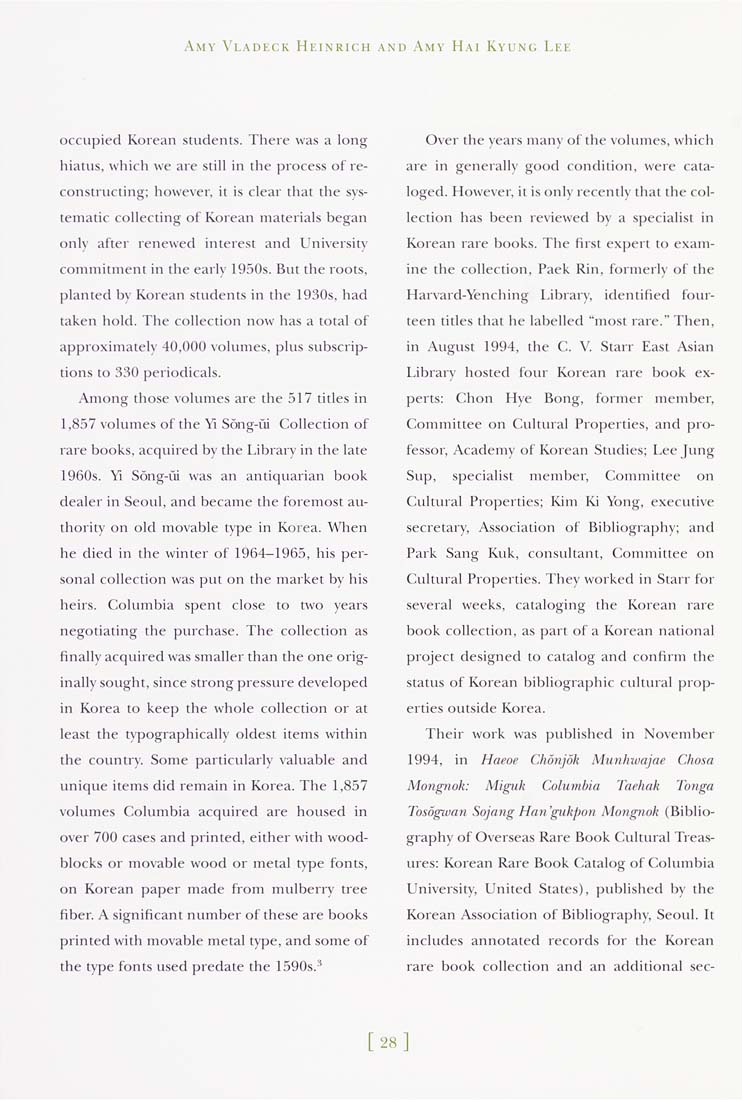Columbia Library columns (v.45(1996))
(New York : Friends of the Columbia Libraries. )
|
||
|
|
|
|
| v.45,no.1(1996:Spring): Page 28 |

Amy Vladeck Heinrich and Amy Hai Kyung Lee occupied Korean students. There was a long hiattis, which we are still in the process of re¬ constructing; however, it is clear that the svs- tematic collecting of Korean materials began only after renewed interest and Universitv commitment in the earlv 1950s. But the roots, planted by Korean sttidents in the 1930s, had taken hold. The collection now has a total of approximately 40,000 volumes, plus subscrip¬ tions to 330 periodicals. Among those \'oliimes are the 517 titles in 1,857 volumes of the Yi Song-Cii Collection of rare books, acquired by the Library in the late 1960s. Yi Song-Cii was an antiquarian book dealer in Seoul, and became the foremost ati- thority on old movable type in Korea. When he died in the winter of 1964-1965, his per¬ sonal collection was put on the market by his heirs. C'ohimbia spent close to two years negotiadng the purchase. The collection as finally acquired was smaller than the one orig¬ inally sought, since strong pressure developed in Korea to keep the whole collection or at least the typographicalK oldest items within the country. Some particularly valuable and unique items did remain in Korea. The 1,857 volumes Columbia acquired are housed in over 700 cases and printed, either with wood¬ blocks or movable wood or metal type fonts, on Korean paper made from mulberry tree fiber. A significant number of these are books printed with movable metal type, and some of the type fonts used predate the 1590s.-^ 0\'er the years man\ of the \()lumes, which are in generally good condition, weie cata¬ loged. However, it is only lecentlv thai the col¬ lection has been reviewed by a specialist in Korean rare books. The first expert to exam¬ ine the collection, Paek Rin, formerh of lhe Harvard-Yenching Library, identihed four¬ teen titles that he labelled "most rare." Then, in Atigust 1994, the C. V. Starr East Asian Library hosted four Korean rare book ex¬ perts: Chon Hye Bong, former member. Committee on Cultural Properties, and pro¬ fessor. Academy of Korean Studies; Lee Jtmg Sup, specialist member, C^onmuUee on Cultural Properties; Kim Ki Yong, execuli\'e secretary. Association of Bibliography; and Park Sang Kuk, consultant, Cxmimittee on Cultural Properties. They worked in Starr for several weeks, cataloging the Koican lare book collection, as part of a Korean national project designed to catalog and confirm the status of Korean bibliograjihic culuiral |)rop- erties outside Korea. Their work was jmblished in N(>vend)er 1994, in Haeoe Chonjok Munhxuajae Chosa Mongnok: Miguk Columbia Taehak Tonga Tosogimn Sojang Han'gukpon Mongiiok (Biblio¬ graphy of Overseas Rare Book Cultural Treas¬ ures: Korean Rare Book Catalog of Columbia University, United States), published by the Korean Association of Bibliography, Seoul. It includes annotated records for the Korean rare book collection and an additional sec- [28: |
| v.45,no.1(1996:Spring): Page 28 |







